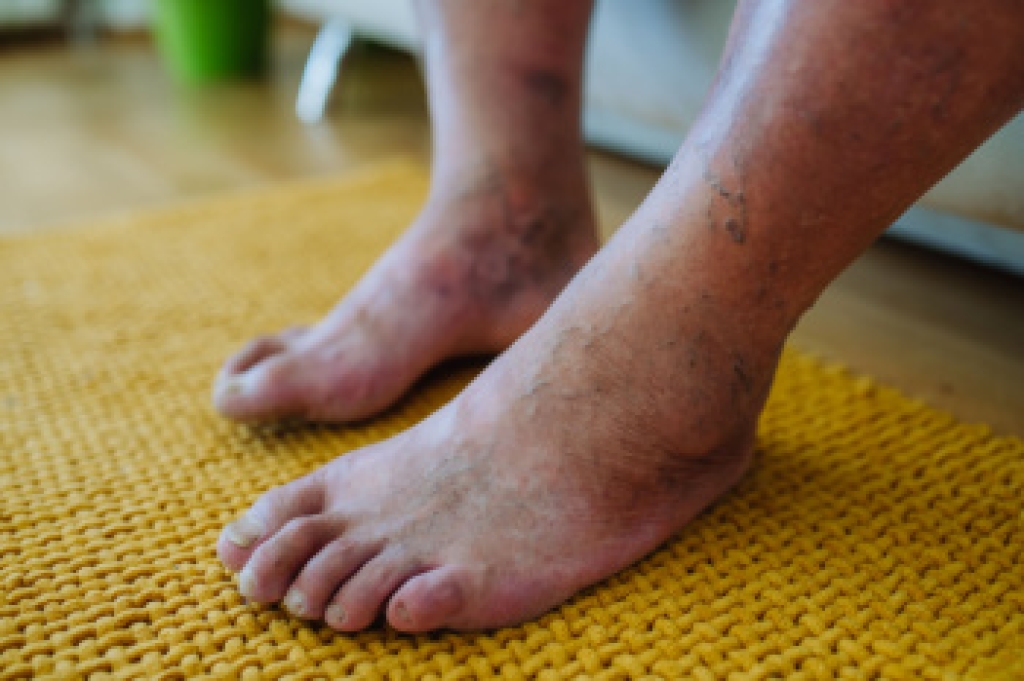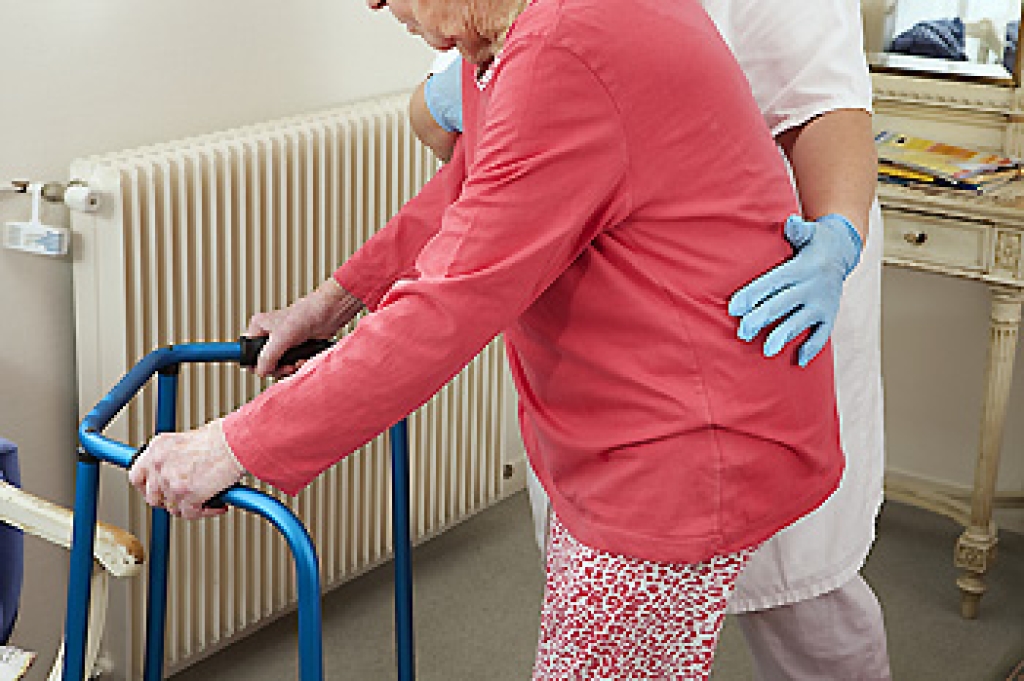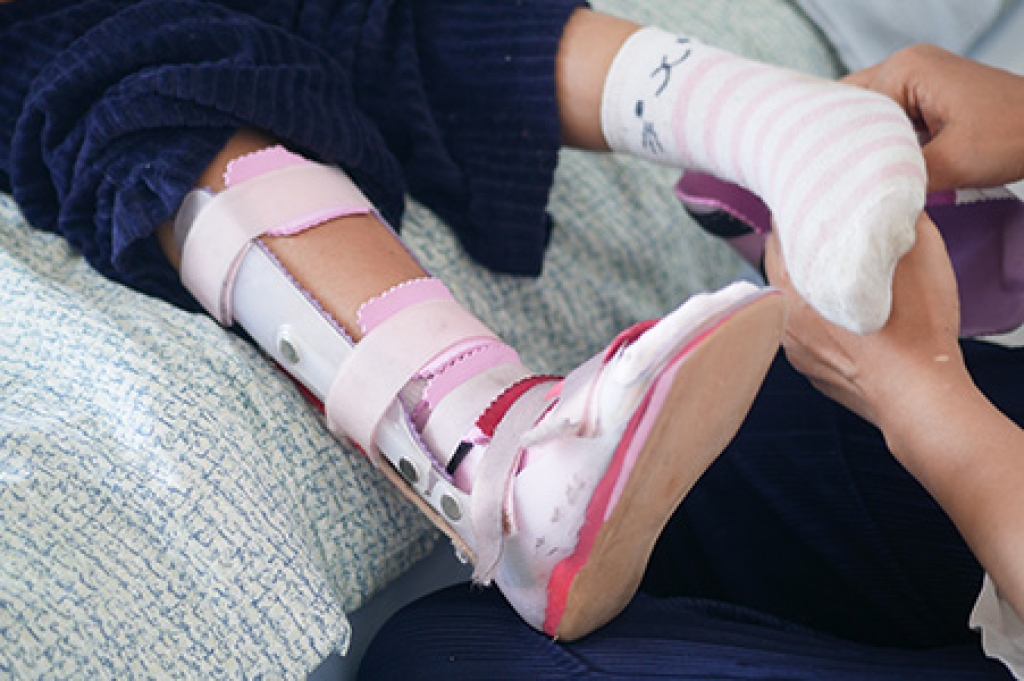Connect With Us
Blog
Blog
Caring for Swollen Feet Related to Diabetes

Swelling in the feet is a common concern for people living with diabetes because circulation, fluid balance, and nerve function can all be affected. Treatment focuses on identifying the cause of the swelling and easing pressure on the tissues. Elevation, wearing supportive footwear, and gentle movement often help improve fluid return, while managing blood sugar can reduce inflammation that contributes to fullness in the feet. Some individuals benefit from compression garments designed specifically for diabetic use, and others may need evaluation for circulation problems or early signs of infection. A podiatrist can assess the skin, nails, and blood flow, recommend safe ways to reduce swelling, and identify any underlying issues that may require more focused care. If your swelling worsens, becomes painful, or makes walking difficult, it is suggested that you see a podiatrist for effective relief tips.
Diabetic foot care is important in preventing foot ailments such as ulcers. If you are suffering from diabetes or have any other concerns about your feet, contact one of our podiatrists from Comprehensive Foot & Ankle Center. Our doctors can provide the care you need to keep you pain-free and on your feet.
Diabetic Foot Care
Diabetes affects millions of people every year. The condition can damage blood vessels in many parts of the body, especially the feet. Because of this, taking care of your feet is essential if you have diabetes, and having a podiatrist help monitor your foot health is highly recommended.
The Importance of Caring for Your Feet
- Routinely inspect your feet for bruises or sores.
- Wear socks that fit your feet comfortably.
- Wear comfortable shoes that provide adequate support.
Patients with diabetes should have their doctor monitor their blood levels, as blood sugar levels play such a huge role in diabetic care. Monitoring these levels on a regular basis is highly advised.
It is always best to inform your healthcare professional of any concerns you may have regarding your feet, especially for diabetic patients. Early treatment and routine foot examinations are keys to maintaining proper health, especially because severe complications can arise if proper treatment is not applied.
If you have any questions, please feel free to contact our offices located in Lehigh Ave and Nazareth Hospital in Philadelphia, Collegeville Darby, and Langhorne, PA . We offer the newest diagnostic and treatment technologies for all your foot care needs.
Falling May Affect the Feet
 Many people have a difficult time recovering from falls that have occurred. Their feet may have become affected, and it may be overwhelming to complete daily activities. There are specific methods that can be implemented that may help to reduce the risk of falling. These can include removing worn rugs from the living environment, installing grab bars in the shower and toilet areas, and it may help to improve existing lighting. Additionally, it is beneficial to have current medication checked by having routine physical and eye examinations performed. Many patients find they may fall less often when the proper shoes are worn. If you would like more information about how possible foot conditions may be avoided by using fall prevention techniques, please confer with a podiatrist.
Many people have a difficult time recovering from falls that have occurred. Their feet may have become affected, and it may be overwhelming to complete daily activities. There are specific methods that can be implemented that may help to reduce the risk of falling. These can include removing worn rugs from the living environment, installing grab bars in the shower and toilet areas, and it may help to improve existing lighting. Additionally, it is beneficial to have current medication checked by having routine physical and eye examinations performed. Many patients find they may fall less often when the proper shoes are worn. If you would like more information about how possible foot conditions may be avoided by using fall prevention techniques, please confer with a podiatrist.
Preventing falls among the elderly is very important. If you are older and have fallen or fear that you are prone to falling, consult with one of our podiatrists from Comprehensive Foot & Ankle Center. Our doctors will assess your condition and provide you with quality advice and care.
Every 11 seconds, an elderly American is being treated in an emergency room for a fall related injury. Falls are the leading cause of head and hip injuries for those 65 and older. Due to decreases in strength, balance, senses, and lack of awareness, elderly persons are very susceptible to falling. Thankfully, there are a number of things older persons can do to prevent falls.
How to Prevent Falls
Some effective methods that older persons can do to prevent falls include:
- Enrolling in strength and balance exercise program to increase balance and strength
- Periodically having your sight and hearing checked
- Discuss any medications you have with a doctor to see if it increases the risk of falling
- Clearing the house of falling hazards and installing devices like grab bars and railings
- Utilizing a walker or cane
- Wearing shoes that provide good support and cushioning
- Talking to family members about falling and increasing awareness
Falling can be a traumatic and embarrassing experience for elderly persons; this can make them less willing to leave the house, and less willing to talk to someone about their fears of falling. Doing such things, however, will increase the likelihood of tripping or losing one’s balance. Knowing the causes of falling and how to prevent them is the best way to mitigate the risk of serious injury.
If you have any questions, please feel free to contact our offices located in Lehigh Ave and Nazareth Hospital in Philadelphia, Collegeville Darby, and Langhorne, PA . We offer the newest diagnostic and treatment technologies for all your foot care needs.
Dealing With Foot-Ankle Deformity in Children

Foot-ankle deformities in children can interfere with proper growth and walking patterns. One example is metatarsus adductus, where the outside border of one or both feet curves inward, giving the foot a bean-like shape. This can develop from the position of the baby in the womb and may affect balance as the child begins to walk. Some children have flexible feet that straighten over time, while others develop stiffness that limits movement. A podiatrist can examine the foot’s flexibility, use imaging if needed, and monitor how the bones and joints are forming. Supportive shoes, orthotic inserts, and stretching exercises can help realign the foot and improve function. In more serious cases, casting or surgery may be required. Early evaluation helps ensure proper development and prevents long-term walking issues. If your child was born with a foot-ankle deformity, it is suggested that you make an appointment with a podiatrist for a diagnosis and treatment.
Congenital foot problems require immediate attention to avoid future complications. If you have any concerns, contact one of our podiatrists of Comprehensive Foot & Ankle Center. Our doctors can provide the care you need to keep you pain-free and on your feet.
Congenital foot problems are deformities affecting the feet, toes, and/or ankles that children are born with. Some of these conditions have a genetic cause while others just happen. Some specific foot ailments that children may be born with include clubfeet, polydactyly/macrodactyly, and cleft foot. There are several other foot anomalies that can occur congenitally. What all of these conditions have in common is that a child may experience difficulty walking or performing everyday activities, as well as trouble finding footwear that fits their foot deformity. Some of these conditions are more serious than others. Consulting with a podiatrist as early as possible will help in properly diagnosing a child’s foot condition while getting the necessary treatment underway.
What are Causes of Congenital Foot Problem?
A congenital foot problem is one that happens to a child at birth. These conditions can be caused by a genetic predisposition, developmental or positional abnormalities during gestation, or with no known cause.
What are Symptoms of Congenital Foot Problems?
Symptoms vary by the congenital condition. Symptoms may consist of the following:
- Clubfoot, where tendons are shortened, bones are shaped differently, and the Achilles tendon is tight, causing the foot to point in and down. It is also possible for the soles of the feet to face each other.
- Polydactyly, which usually consists of a nubbin or small lump of tissue without a bone, a toe that is partially formed but has no joints, or an extra toe.
- Vertical talus, where the talus bone forms in the wrong position causing other bones in the foot to line up improperly, the front of the foot to point up, and the bottom of the foot to stiffen, with no arch, and to curve out.
- Tarsal coalition, when there is an abnormal connection of two or more bones in the foot leading to severe, rigid flatfoot.
- Cleft foot, where there are missing toes, a V-shaped cleft, and other anatomical differences.
- Macrodactyly, when the toes are abnormally large due to overgrowth of the underlying bone or soft tissue.
Treatment and Prevention
While there is nothing one can do to prevent congenital foot problems, raising awareness and receiving neonatal screenings are important. Early detection by taking your child to a podiatrist leads to the best outcome possible.
If you have any questions, please feel free to contact our offices located in Lehigh Ave and Nazareth Hospital in Philadelphia, Collegeville Darby, and Langhorne, PA . We offer the newest diagnostic and treatment technologies for all your foot care needs.
Severs Disease in Growing Children

Severs disease is a common cause of heel pain in growing children and occurs when the growth plate at the back of the heel becomes irritated. This condition often develops during growth spurts, and is considered an overuse injury rather than a true disease. Risk factors include high impact sports, tight calf muscles, wearing improper footwear, and rapid physical development. Children may experience heel soreness, swelling, stiffness, or discomfort during activity. A podiatrist can provide guidance through proper evaluation, supportive shoe gear, custom orthotics, and stretching plans to reduce strain on the heel. Early care helps children stay active without unnecessary pain. If your active child has heel pain, it is suggested that you consult a podiatrist who can offer effective relief tips.
Sever's disease often occurs in children and teens. If your child is experiencing foot or ankle pain, see one of our podiatrists from Comprehensive Foot & Ankle Center. Our doctors can treat your child’s foot and ankle needs.
Sever’s Disease
Sever’s disease is also known as calcaneal apophysitis, which is a medical condition that causes heel pain I none or both feet. The disease is known to affect children between the ages of 8 and 14.
Sever’s disease occurs when part of the child’s heel known as the growth plate (calcaneal epiphysis) is attached to the Achilles tendon. This area can suffer injury when the muscles and tendons of the growing foot do not keep pace with bone growth. Therefore, the constant pain which one experiences at the back of the heel will make the child unable to put any weight on the heel. The child is then forced to walk on their toes.
Symptoms
Acute pain – Pain associated with Sever’s disease is usually felt in the heel when the child engages in physical activity such as walking, jumping and or running.
Highly active – Children who are very active are among the most susceptible in experiencing Sever’s disease, because of the stress and tension placed on their feet.
If you have any questions, please feel free to contact our offices located in Lehigh Ave and Nazareth Hospital in Philadelphia, Collegeville Darby, and Langhorne, PA . We offer the newest diagnostic and treatment technologies for all your foot care needs.
Blog Archives
- 2026
- 2025
- 2024
- 2023

